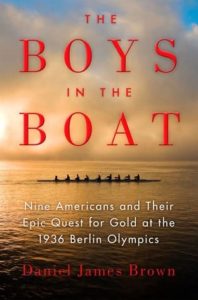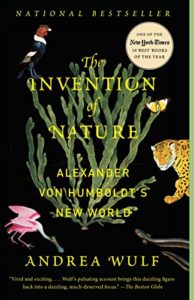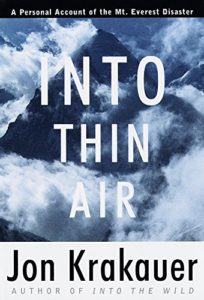With most people spending more time at home these days, what better place to escape to than a good book? While real-life adventures are on hold, we can still live vicariously through others’ past adventures, real or fictional. Take a look at this list of some of GMC staff’s favorite outdoor adventure books:
Lorne Currier, Volunteer & Education Coordinator:

The Boys in the Boat by Daniel James Brown
This book is about nine Americans from the University of Washington’s crew team. The team of working-class boys perseveres through societal discrepancies, family challenges, the turmoil of the pre-WWII years, and many cold training sessions on the water to compete in the 1936 Berlin Olympics. At a time when the tensions of the world are high and the University of Washington a true underdog, the way that this team focuses on the simple act of rowing to find their happiness reminds me of myself when I’m in the outdoors. It’s a great read and made me desperately want to sit in a boat and push myself beyond limits to meet the stroke.
Mike DeBonis, Executive Director:

To Build a Fire by Jack London
I first read this story on my very first winter camping trip. My scout troop went to Battell Shelter and slept in the lean-to. After dinner, we drank hot cocoa that tasted like the leftover pasta water it was made with and took turns reading the story by flashlight. I had never slept outside in winter before and the story seemed so real and vivid. I still drink leftover pasta water when camping because it brings back fond memories of reading Jack London and sleeping outside in the snow.
Rick Dugan, Database Coordinator

Endurance by Alfred Lansing
This book is one of the all-time great adventure and survival stories, following the journey of Sir Ernest Shackleton and his crew of the ship Endurance as they embark to Antarctica to attempt to traverse the entire uncharted continent on foot. The exploration becomes a struggle for survival as things take a turn for the unexpected, and the result is one of the most incredible survival stories ever documented. The trials and tests the crew of the Endurance had to face are harrowing and seemingly neverending, and it makes me appreciate celebrating adventures – no matter how big or small – in the spirit of getting lost.

Life of Pi by Yann Martel
At first glance, the description of a boy sharing a small lifeboat left adrift at sea with a full-grown Bengal tiger makes very little sense – that is one of the focal points that author Yann Martel hopes to emphasize through this incredible journey. The author manages to balance themes of religion and friendship, isolation and connectedness, and ultimately fiction and reality in this saga. I have read and re-read this book several times, and each solitary trip across the ocean with Pi manages to draw some new and exciting introspection. In many ways, Pi manages to optimize the plight and passage of the human spirit in this surreal journey with his feline companion. I never cease to laugh and cry many times throughout this tale, and it always leaves me feeling as if I am glowing from the inside out when I finish. The overall message carries that people are capable of incredible feats, even in the most obscure versions of isolation and extraordinary circumstances. I think that message is important now more so than other times. Life of Pi is an amazing story of adventure and will, and I believe that every reader has something unique to gain by reading this book.
Anthony Erwin, VHCB AmeriCorps Stewardship Assistant

The Shadow of Kilimanjaro: On Foot Across East Africa by Rick Ridgeway
Traversing Kenya from the peak of Kilimanjaro to the edge of the Indian Ocean, Rick Ridgeway captures the thrill and adventure of trekking in Africa and explains the history of the Kenya Wildlife Service (KWS) along the way. A friend of mine recommended this book to me while I was prepping for my first trip to Kenya. It immediately blew me away and succeeded in solidifying my lifelong interest in experiencing and exploring East Africa. This book truly illustrates what it is like to get off the beaten path in wild areas of a magnificent country.
Kristin McLane, Membership & Communications Manager

Canyon Solitude: A Woman’s Solo River Journey Through Grand Canon by Patricia McCairen
Patricia McCairen was the first woman to raft the Colorado River through the Grand Canyon solo and this is her account of that trip. While her descriptions of the trip itself – the act of rafting, the river, the rapids, the canyon – paint a vivid picture of what rafting through the Grand Canyon is like, what I enjoyed the most was her internal journey. She could be everywoman on this adventure: struggling with fear, what it means to be alone, and society’s expectations. McCairen used to have a corporate job, but after one short trip on the Colorado River, she gave up everything to make rafting her life. While running rivers, she escapes into an identity called “Patch,” where she is free to do as she pleases instead of pleasing others. She wins a coveted private permit to raft the Grand Canyon in their lottery system, and when no one is able to join her, makes the decision to go it alone. She saw a few other people in the canyon during her month on the water, but spent the majority of her time solo, making her own choices and accepting all risks.
 Give Me the Hills by Miriam Underhill
Give Me the Hills by Miriam Underhill
Miriam Underhill began climbing as a teenager in the Alps. She started out with guides, but quickly realized that to really gain skill, and have some more fun, she’d need to lead her own climbs. And in order to be taken seriously, men could not help in the ascents at all. She and some female friends completed several all-women climbs between 1929 and 1931. Then she married Robert Underhill, and he became her lifelong climbing partner. After the war, they restricted their climbing to the States for a while, putting up first ascents in Wyoming, Idaho, and Montana. Later, they were founding members of the Four Thousand Footer game in New Hampshire, and Miriam came up with the winter game rules. This memoir is a great look at the life of a woman mountaineering back when it was a pretty unusual pastime. Underhill explains the logistics of her climbs very matter of factly, glossing over any risks or discomfort with a dry sense of humor.
John Plummer, Group Outreach & Field Coordinator

The Invention of Nature: Alexander von Humboldt’s New World by Andrea Wulf
One of my favorite adventure books of late is one that my brother gave me a couple of years ago. The Invention of Nature by Andrea Wulf recounts the extraordinary life of the Prussian polymath, naturalist, explorer, and geographer Alexander von Humboldt (b. 1769). Humboldt took part in some of the grandest adventures of his time, all while slowly building a view of the world which informs much of the way we regard nature today. He traveled from Europe to Central and South America, where he trekked through jungles and over mountains in search of new and interesting pockets of life. Though often overlooked today, he was one of the first to begin synthesizing knowledge of many different disciplines into a grand vision of nature as one interconnected system. This story takes you from Humboldt’s time spent with Goethe in his youth, to America where he advised Jefferson, through a Siberian expedition, and on to the formation of his masterwork, Kosmos. This biography has just as much adventure as it does nature.
Amy Potter, Visitor Center Manager

On Trails: An Exploration by Robert Moor
Robert Moor first started thinking about trails on his Appalachian Trail thru hike and turned his investigation into a fellowship research topic that resulted in this book. On Trails takes an interesting look at the evolution of trails. It starts with the first evidence of trails made at the microscopic level and goes through the history of how trails have grown and the philosophy of how the use of trails has changed over time. Moor explores how and why trails are created by humans, and even more, how trails affect our behavior. He advocates for changing our thoughts around trails and wilderness to make them not some far off abstract, but a part of our daily lives.
 Into Thin Air by Jon Krakauer
Into Thin Air by Jon Krakauer
You’ve probably heard of the May 1996 Mount Everest disaster where eight mountaineers died after getting caught in a blizzard while trying to descend from the summit of the world’s tallest peak. Journalist Jon Krakauer was there and recounts his experience in this book. Although it is non-fiction, I think it will appeal to those who like fiction as well. There are a lot of intense, dramatic, nail-biting moments.



















Great list. I have read the last three books on it and several others look interesting. I am currently reading Bill McKibben’s Wandering Home, which I highly recommend. His hike starts on the LT up Mt. Abe.